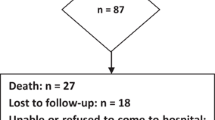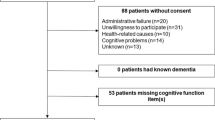Abstract
All living adults with histopatologically proven diagnosis of low-grade glioma in a Swedish county were identified with help of the Regional Cancer Register, half of them (n = 24) participated in a neuropsychological evaluation. A considerable variation was found in cognitive function within this group of patients, ranging from good ability to severe disturbance. Different patterns of cognitive dysfunction emerged resulting in three subgroups; patients with severe, mild, and minimal selective dysfunction. The patients with severe disturbance had a global dysfunction covering most assessed cognitive domains. Slow information-processing speed was obvious in the subgroups with both severe and mild dysfunction. Cognitive problems present in the best performing group seemed related to tumor localization. Cognitive function in the whole sample was related to histopathological diagnosis of the tumor, as well as to educational level of the patients. The nonworking patients had significantly poorer performance than the working patients.
Similar content being viewed by others
References
Armstrong, C. L., Corn, B. W., Ruffer, J. E., Pruitt, A. A., Mollman, J. E., & Phillips, P. C. (2000). Radiotherapeutic effects on brain function: Double dissociation of memory systems. Neuropsychiatry, Neuropsychology, and Behavioral Neurology, 13, 101–111.
Ater, J. L., Moore, B. D., Francis, D. J., Castillo, R., Slopis, J., & Copeland, D. R. (1996). Correlation of medical and neurosurgical events with neuropsychological status in children at diagnosis of astrocytoma: Utilization of a neurological severity score. Journal of Child Neurology, 11, 462–469.
Benton, A. L., Sivan, A. B., deS Hamsher, K., Varney, N. R., & Spreen, O. (1994). Contributions to neuropsychological assessment (2nd ed.). New York: Oxford University Press.
Bergman, I., Blomberg, M., & Almkvist, O. (2004) Variation of health status in normal individuals has an influence on cognition in addition to demographics. Manuscript in preparation, Karolinska Institute, Department of Neurotec, Stockholm.
Chadderton, R. D., West, C. G. H., Schulz, S., Quirke, D. C., Gattamaneni, R., & Taylor, R. (1995). Radiotherapy in the treatment of low-grade astrocytomas II. The physical and cognitive sequelae. Child’s Nervous System, 11, 443–448.
Drake, A. I., Gray, N., Yoder, S., Pramuka, M., & Llewellyn, M. (2000). Factors predicting return to work following mild traumatic brain injury: A discriminant analysis. Journal of Head Trauma Rehabilitation, 15, 1103–1112.
Gladsjo, J. A., Miller, S. W., & Heaton, R. K. (1999). Norms for letter and category fluency: Demographic corrections for age, education, and ethnicity. Odessa: Psychological Assessment Resources, Inc.
Hoffman, H. J., Berger, M. S., & Becker, L. E. (1990). Cerebellar astrocytomas. In M. Deutsch (Ed.), Management of childhood brain tumors (pp. 441–456). Boston: Klüwer Publishers.
Hunt, E. (1995, July–August). The role of intelligence in modern society. American Scientist, Article 95. Retrieved November 29, 2002, from http://www.americanscientist.org/articles/95articles/Hunt-full.html
Jagaroo, V., Rogers, M. P., & Black, P. M. (2000). Allocentric visuospatial processing in patients with cerebral gliomas: A neurocognitive assessment. Journal of Neuro-Oncology, 49, 235–248.
Kernohan, J. W., Mabon, R. F., Svien, H. J., & Adson, A. W. (1949). A simplified classification of the gliomas. Staff Meetings of the Mayo Clinic, 2, 71–75.
Kleihues, P., Louis, D. N., Scheithauer, B. W., Rorke, L. B., Reifenberger, G., Burger, P. C., et al. (2002). The WHO classification of tumors of the nervous system. Journal of Neuropathology & Experimental Neurology, 61, 215–225.
Klein, M., Engelberts, N. H. J., van der Ploeg, H. M., Kasteleijn-Nolst Trenité, D. G. A., Aaronson, N. K., Taphoorn, M. J. B., et al. (2003). Epilepsy in low-grade gliomas: The impact on cognitive function and quality of life. Annals of Neurology, 54, 514–520.
Klein, M., Heimans, J. J., Aaronson, N. K., van der Ploeg, H. M., Grit, J., Muller, M., et al. (2002). Effect of radiotherapy and other treatment-related factors on mid-term to long-term cognitive sequelae in low-grade gliomas: A comparative study. The Lancet, 360, 1361–1368.
Laursen, P. (1997). The impact of aging on cognitive functions. Acta Neurologica Scandinavica Supplementum, 96(172).
Malm, J., Kristensen, B., Karlsson, T., Carlberg, B., Fagerlund, M., & Olsson, T. (1998). Cognitive impairment in young adults with infratentorial infarcts. Neurology, 51, 433–440.
Mathiowetz, V., Weber, K., Kashman, N., & Volland, G. (1985). Adult norms for the nine hole peg test of finger dexterity. The Occupational Therapy Journal of Research, 5, 24–38.
Meyers, C. A., & Kayl, A. E. (2002). Neurocognitive Function. In V. A. Levin (Ed.), Cancer in the nervous system (2nd ed., pp. 557–571). Oxford: Oxford University Press.
Meyers, C. A. (1986). Neuropsychologic deficits in brain-tumor patients: Effects of location, chronicity and treatment. The Cancer Bulletin, 38, 30–32.
Meyers, C. A., & Scheibel, R. S. (1990). Early detection and diagnosis of neurobehaivioral disorders associated with cancer and its treatment. Oncology, 4, 115–122.
Mulhern, R. K., Kovnar, E. H., Kun, L. E., Crisco, J. J., & Williams, J. M. (1988). Psychologic and neurologic function following treatment for childhood temporal lobe astrocytoma. Journal of Child Neurology, 3, 47–52.
Mulhern, R. K., & Kun, L. E. (1985). Neuropsychologic function in children with brain tumors: III. Interval changes in the six months following treatment. Medical and Pediatric Oncology, 13, 318–324.
Nelson, D. F., McDonald, J. V., Lapham, L. W., Qazi, R., & Rubin, P. (1993). Central nervous system tumors. In P. Rubin (Ed.), Clinical oncology (pp. 617–644). Philadelphia: WB Saunders Company.
Nybo, T., & Koskiniemi, M. (1999). Cognitive indicators of vocational outcome after severe traumatic brain injury (TBI) in childhood. Brain Injury, 13, 759–766.
Pignatti, F., van den Bent, M., Curran, D., Debruyne, C., Sylvester, R., Therasse, P., et al. (2002). Prognostic factors or survival in adult patients with cerebral low-grade glioma. Journal of Clinical Oncology, 20, 2076–2084.
Påhlson, A., Ek, L., Ahlström, G., & Smits, A. (2003). Pitfalls in the assessment of disability in individuals with low-grade gliomas. Journal of Neuro-Oncology, 65, 149–158.
Riva, D., & Benton, A. (1993). Visuospatial judgment: A crossnational comparison. Cortex, 29, 141–143.
Schmidt, M. (1996). Rey auditory and verbal learning test: A handbook. Los Angeles: Western Psychological Services.
Sichez, N., Chatellier, G., Poisson, M., & Delattre, J. Y. (1996). Gliomes sus-tentoriels: Étude neuropsyhologique des survivants à long terme [Supratentorial gliomas: neuropsychological assessment of long-term survivors]. Revue Neurologique, 152, 261–266.
Smith, A. (1982). Symbol Digit Modalities Test: Manual. Los Angeles: Western Psychological Services.
Steinlin, M., Imfeld, S., Zulauf, P., Boltshauser, E., Lövblad, K.-O., Lüthy, A. R., et al. (2003). Neuropsychological long-term sequelae after posterior fossa tumour resection during childhood. Brain, 126, 1998–2008.
Surma-aho, O., Niemelä, M., Vilkki, J., Kouri, M., Brander, A., Salonen, O., et al. (2001). Adverse long-term effects of brain radiotherapy in adult low-grade glioma patients. Neurology, 56, 1285–1290.
Sweet, J. J., Nies, K. J., Lorber, R., & Vick, N. A. (1994). Relative absence of neuropsychological deficit in patients with low grade astrocytomas. Journal of Clinical Psychology in Medical Settings, 1, 83–104.
Taphoorn, M. J. B., Heimans, J. J., Snoek, F. J., Lindeboom, J., Oosterink, B., Wolbers, J. G., et al. (1992). Assessment of quality of life in patients treated for low-grade glioma: A preliminary report. Journal of Neurology, Neurosurgery, and Psychiatry, 55, 372–376.
Taphoorn, M. J. B., Schiphorst, A. K., Snoek, F. J., Lindeboom, J., Wolbers, J. G., Karim, A. B. M. F., et al. (1994). Cognitive functions and quality of life in patients with low-grade gliomas: The impact of radiotherapy. Annals of Neurology, 36, 48–54.
Tucha, O., Smely, C., Preier, M., & Lange, K. W. (2000). Cognitive deficits before treatment among patients with brain tumors. Neurosurgery, 47, 324–334.
Wechsler, D. (1981). Wechsler adult intelligence scale-revised (Swedish version by Bartfai, A., Nyman, H., & Stegmann, B., 1994), Stockholm: Psykologiförlaget.
Vigliani, M.-C., Sichez, N., Poisson, M., & Delattre, J.-Y. (1996). A prospective study of cognitive functions following conventional radiotherapy for supratentorial gliomas in young adults: 4-Years results. International Journal of Radiation Oncology Biology, Physics, 35, 527–533.
Author information
Authors and Affiliations
Corresponding author
Rights and permissions
About this article
Cite this article
Ek, L., Smits, A., Påhlson, A. et al. Analysis of Cognitive Dysfunction in Patients with Low-Grade Glioma. J Clin Psychol Med Settings 12, 165–173 (2005). https://doi.org/10.1007/s10880-005-3276-7
Issue Date:
DOI: https://doi.org/10.1007/s10880-005-3276-7




